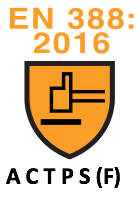EN388: 2016
Protection against mechanical risks

The level of the glove protection against mechanical risks is represented by a pictogram followed by 4 digits and 1 letter which correspond to the performance levels.
Regarding the digits, the level goes from 0 to 4 or 5 depending on the risks. 0 beeing the weakest perfomance and 4 or 5 the highest.
Regarding the letter, the level goes from A to F depending on the risks. A beeing the weakest perfomance and F the highest.
If the indicated level is X, this means that the glove has not beeing tested against this mechanical risk.
Performance levels explanation of the norm EN 388:2016:
|
Performance level
|
0 | 1 | 2 | 3 | 4 |
5
|
| A. Abrasion resistance (cycle) |
<100 |
100 |
500 |
2000 |
8000 |
|
| C. Couptest cut resistance (factor) |
<1.2 |
1.2 |
2.5 |
5 |
10 |
20 |
| T. Tear resistance (Newton) |
<10 |
10 |
25 |
50 |
75 |
|
| P. Resistance against perforation (Newton) |
<20 |
20 |
60 |
100 |
150 |
|
|
Performance level
|
A | B | C | D | E |
F
|
| S. TDM cut resistance (factor) |
2 |
5 |
10 |
15 |
22 |
30 |
| F. Impact resistance |
Passed | Failed |
A letter of the pictogram: Abrasion resistance
C letter of the pictogram: Cut resistance by blade (trenching)
It determines the cut resistance by blade by counting the number of cycles necessary for a circular blade rotating at constant speed, in reciprocity, with a constant pressure of 5N (approximately 500g) to cut the glove. This method that evaluates the glove cut resistance is the so-called method of Couplets.
T letter of the pictogram: Tear resistance
It determines the force needed to tear the glove. An incision is made in the material of the glove, the force required to tear the material is then measured (in Newton, N). The lowest level of performance is level 0, corresponding to a force of less than 10 N. The highest level of performance is level 4, corresponding to a force of 75 N.
P letter of the pictogram: Resistance against perforation
It determines the force required to pierce the glove. A standard size tip is used at a given speed (10 cm/min). The force required to perforate the material is then measured. This force is measured in Newton (N). The lowest level of performance is level 0, corresponding to a force of less than 20 N, the highest level of performance is level 4, corresponding to a force of 150 N.
S letter of the pictogram: Cut resistance according to EN ISO 13997
It determines the force required to cut the glove with a blade under a given pressure in a single displacement. The force required to cut the material is then measured. This force is measured in Newton, with a force ranging from 2 to 30 N. The lowest level of performance is level A, corresponding to a force of 2 N, the highest level of performance is level F, corresponding to a force of 30 N. This method for evaluating the resistance to cutting is the so-called TDM method. If the TDM test is not performed, the letter of the pictogram will be an "X".
(F) letter of the pictogram: Impact resistance according to EN 13594
It determines the protection of the glove against shocks. If the glove passes the test, the letter "F" will be added after the 4 digits and the letter under the pictogram.